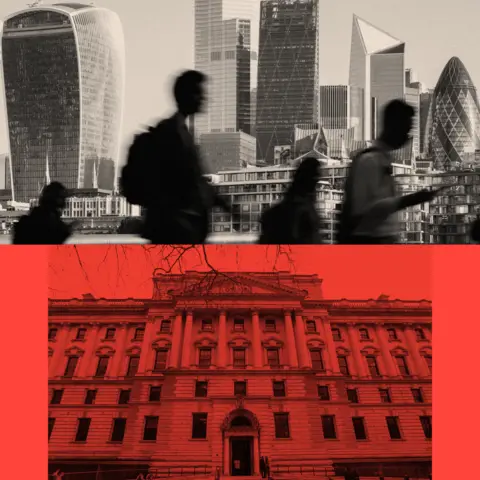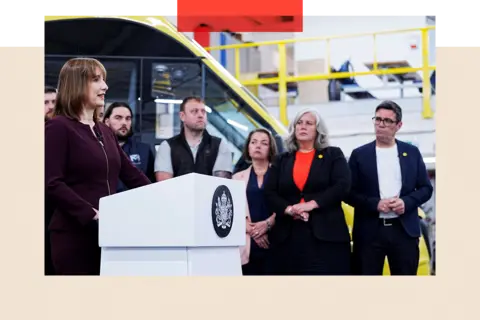

 BBC
BBCThe strategising and multi-year planning going on ahead of this week’s Spending Review is the bread and butter of any well-run economy.
A Spending Review shows how resources are being allocated between departments and so indicates the government’s “when-push-comes-to-shove” priorities. But this time it will be a “different sort of Spending Review”, the chancellor’s helpers are saying.
That’s because with the new government nearly one year old, this Spending Review is also a one-off opportunity to show the private sector and international investors that it has a confident, deliverable vision.
But having tiptoed cautiously throughout its first year in office, the question is whether this government can convince those potential investors that the economic vision is real? And will other long-term challenges, such as industrial energy prices, social care costs, and worker illness be prioritised or parked?
‘Stop playing tiny domestic politics’
Some chief executives tell me they cannot fathom why a government with such a huge majority can sometimes appear to be scared of its own shadow.
There had been talk of Downing Street “wanting to have fights” over planning for major projects. But companies that have major investors waiting to invest in the factories that could start rolling out the mass adoption of green technologies are wondering whether Downing Street really will back them, given the polls, and possible net zero backlash.
“They need to stop playing tiny domestic politics,” one boss of a major consumer company told me, as he awaits a convincing solid vision.
 WPA Pool/ Getty Images
WPA Pool/ Getty ImagesIt is with big investors in mind that the chancellor’s focus at this spending review has been on long-term capital spending – that’s where the big numbers come in.
The proportion of the country’s GDP that is being earmarked for capital spending, is 2.7% on a five-year average. If that doesn’t strike you as eye-watering, it’s worth noting it will be at its highest sustained level for nearly half a century. It will be significantly higher than under Brown-Darling in 2010. In 2000 this number was 0.5%.
Of course, allocating significant sums is not a guarantee that the money will be spent effectively, or even at all. Spending on capital is often subject to the rollercoaster of short-term government priorities.
In a crisis it tends to be the first thing to get hacked back, because the loss of future buildings or roads or rail lines is less politically troublesome than cutting back a public service or, say, teachers’ pay in the here and now.
That’s why under the chancellor’s new borrowing rules, the money can at least be allocated to big capital projects. Her reforms to those rules – keeping them strict on day-to-day spending, but consciously allowing more space for long-term investment – were designed for this.
The main goal being future growth.
Time to ‘rewire the state’
Long-term certainty over the capital sums that are being allocated over the next week or so, could be a gamechanger. Private investment is more likely to follow if there are long-term plans in place, especially after so many years of political uncertainty.
As part of all this, the chief secretary to the Treasury is also announcing increases in spending on research and development. That is designed to boost science-led growth.
But the marquee project for this announcement will surely be the long-awaited high-speed rail line between Liverpool and Manchester. It is a piece of infrastructure forged in the fires of the UK’s industrial heritage, including the world’s first inter-city passenger line, and of course Stephenson’s Rocket, the original steam locomotive.
Now, 200 years on from its launch in 1829, it may well be time for another industrial revolution, of sorts.
 Reuters
ReutersBut make no mistake, the government has still had to make some big choices, even within a more generous capital budget. Most of the increase in defence spending announced last week is in the form of capital spending.
When the documents are published on Wednesday, it is possible that some other capital projects will have been squeezed to make room.
All departments have also reassessed spending from first principles, as part of a “zero-based” review. In theory there could be entire projects axed. There will also be a lot of “investing to spend less”. Using the capital budget to invest in, say, AI scanners in the health service, in a way that ultimately is supposed to save money.
The aim, ambitiously put, is to “rewire the state” and “get Britain moving”.
It is with this in mind, that the chancellor will promise the government has learnt the lessons of capital spending debacles, such as HS2.
She believes that by waiting, and carefully preparing an infrastructure strategy, she is making sure the spending will go where it will most boost growth. Freeing up supply, for example in the planning system, is supposed to help the rebuilding boom, but without provoking inflation.
The long shadow of Covid-19
Those new borrowing rules that freed up spending on big projects, also mean tight settlements on day-to-day spending.
The travails of Elon Musk and Donald Trump show the challenges for G7 countries in managing public finances. And Labour are operating in an environment where some opposition parties are now advocating more radical surgery to the size of the state in the UK.
Moreover, when it comes to public spending there is still the long shadow from the pandemic. Demand for acute services and benefits related to ill health and care, or special needs, is eating far into budgets for councils, schools and health.
The public seems to expect more from the state since the pandemic, even if it does not want to stump up the taxes to pay for it.
 PA Media
PA MediaSo budgetary pressures have not gone away. It is, right now, difficult to square extra welfare spending on winter fuel payments and child benefit, extra defence spending, and sticking to the chancellor’s rules without some further tax rises in the autumn.
Faster growth numbers, and an upturn in confidence after the series of trade deals, could help make the numbers add up, but there are any number of economic uncertainties out there too.
While there have been some strained moments in negotiations with Cabinet colleagues, all parties have already negotiated a mini-Spending Review for this year.
But that is not to say the chancellor doesn’t have to perform a massive balancing act: juggling demands to keep the short-term budget numbers adding up, while unleashing the long-term investment that could finally get the economy growing again.
BBC InDepth is the home on the website and app for the best analysis, with fresh perspectives that challenge assumptions and deep reporting on the biggest issues of the day. And we showcase thought-provoking content from across BBC Sounds and iPlayer too. You can send us your feedback on the InDepth section by clicking on the button below.







